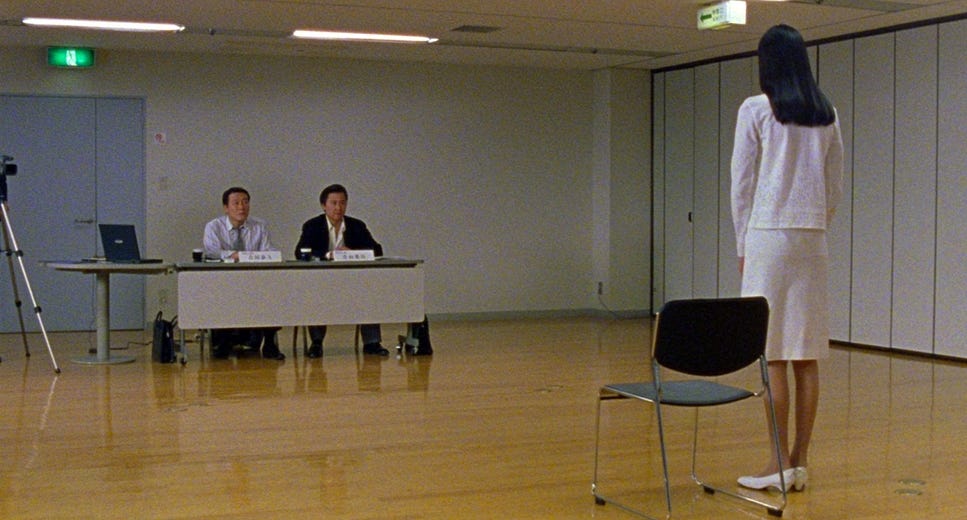🎬 #85 Why can Japanese cinema feel so eerie?
First, a welcome to anyone who’s just subscribed, and secondly a deep, deep thank you to everyone else who’s been subscribed for a while.
I feel like there’s a fundamental difference between horror and the feeling of eeriness. The word that best sums it up for me is the German ‘unheimlich.’ The feeling of weirdness or oddness - that something is not quite right.
The films that consistently deliver this feeling, in a way that few can match, come from Japan. Excellent Japanese filmmakers there always nail that ‘off’ feeling. So this week, it’s two films that I feel exemplify the genre of Japanese eerie best. A genre all to itself.
A warning to all that some of the material in both this week’s films is deeply unsettling and might be a bit much to watch back to back. Or if you’re feeling hardcore, enjoy in a double bill.
Happy choosing, happy viewing
Bry
FILM ONE: CURE
1997 Dir Kiyoshi Kurosawa
This film’s closest relative might be David Fincher’s Se7en. Similar to that film, there is a sense of deep hopelessness that drapes over every frame. A detective story that involves the detective easily tracking down the killer only for things to become more complicated after the point most detective stories would be resolved. It’s such a nice, fresh take on the detective-tracking-the-killer tropes we’ve come to see throughout film. But onto that special unheimlich feeling.
It’s a combination of different cinematic factors. The choices of muted tones in wardrobe and set throughout - old hospital off-whites, greasy browns, greys, musty beiges. This muted factor gives the world of the film a feeling that all colour is drained out, never to return. Like a deep hangover, it feels like the world will never have any brightness again, there won’t be another colourful, hopeful day. Even a scene at the seaside has all the happiness of the location bleached out. It’s bleak.
It’s also down to the character of the spaces used. The boxed-in feeling of a mega-city, traditional architecture with more modern additions built on top. The idea that there is a constant layering of times and ages, many things have existed in this one place. All of the characters are trapped inside it, in a big maze without resolution.
One of my favourite moments is a normal dinner scene. The table is set perfectly, all the cutlery is neatly arranged. But once the plate cover is lifted, a single raw piece of beef is revealed. One simple change that transforms the scene completely. That’s maybe the simplest description of how this special brand of Japanese eerie-ness is achieved. One simple thing, twisted, changed. The story of a detective who finds the killer easily. The strangeness only grows from there.
TL;DR Kiyoshi Kurosawa’s Cure is a pure exercise in messing with the detective genre, pop it on to delve into the unfolding mystery, and get that special eerie feeling only Japanese cinema can provide.
*Available to Criterion Collection subscribers in the US and in the UK if you have a VPN.
Fact: Bong Joon-ho, director of Parasite, lists this film as one of the most influential on his career.
FILM TWO: AUDITION
1999 Dir Takashi Miike
A synopsis of Miike’s film could be written that makes it seem like a 90’s romcom. A lonely, widowed TV executive finds his new gf with the help of his friend, who sets up a fake audition for a TV show. And as a romcom it would be great.
The astonishing thing here is that what seems normal, just isn’t. That’s the unheimlich trick with Audition. Nothing about the how the film is handled gives away what is to come. In essence, Miike is making a romcom, until he isn't.
Take the above frame as an example. Shigeharu, the lead, a happy, excited man on the verge of discovering love after the loss of his wife. A feeling of ‘koi no yokan,’ Japanese for the feeling of anticipation of love, without it being there quite yet. This frame tells the story of hope, possibility, the movement away from pain and suffering. It’s colourful, brightly lit - the framing and position of the character within the frame is all ‘traditional.’ The symbolism of ‘normal' within cinematic language. There’s a reason why comedies and romantic comedies are handled in predominantly traditional cinematic ways, the same angles, brightly graded, shadow-less - it’s all about joy and happiness. Contrast this frame with the one below and you’ll get some idea where the film goes.
I really don’t want to say anything more about the film - the best way to experience it is to go in without watching the trailer or reading any more about it. It’s the contrasting worlds at work in the film that make it truly memorable, truly eerie.
TL;DR Miike’s film is best enjoyed by knowing as little about it as possible, only then can you really feel the power of the unbelievably eerie state it achieves, going from 0 to 100 in the blink of an eye.
*Available for a small rental fee on Amazon, Apple, Google and YouTube in the UK and Apple in the US.
Fact: Tarantino described the film as a ‘true masterpiece if ever there was one.’






